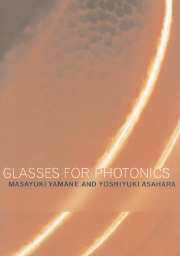4 - Nonlinear optical glass
Published online by Cambridge University Press: 30 July 2009
Summary
Introduction
There has been considerable activity in the development of photonics devices such as all-optical switches and modulators for many applications in optical communication and optical computer systems. The success of such devices depends on the development of nonlinear optical materials. Various types of glass are very attractive materials for these applications, because of their strong nonlinearities and their relatively fast response time, and in addition, they are mechanically durable and are compatible with fiber and waveguide fabrication procedures. They are also very attractive from the basic viewpoint of understanding the physical mechanisms of optical nonlinearities in materials. Generally, optical nonlinearities of glass materials can be divided into two principal categories [1, 2]: resonant and nonresonant.
Nonresonant nonlinear glasses range from optical glasses to high-refractive-index glasses such as heavy-metal oxide glasses and chalcogenide glasses, and resonant nonlinear glasses including composite glasses containing semiconductor or metal microcrystallites. These have been the subject of investigation, although further developments in photonics switching and information processing will depend critically on the continuing development of improved glass materials. In this chapter, we first give a brief survey of the fundamentals of nonlinear optics and their applications, and then describe the physical mechanisms, the fabrication, and the characteristics of nonlinear glass materials and several examples of their application.
- Type
- Chapter
- Information
- Glasses for Photonics , pp. 159 - 241Publisher: Cambridge University PressPrint publication year: 2000
- 2
- Cited by



